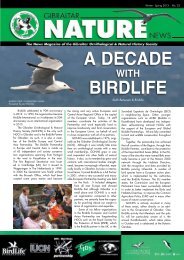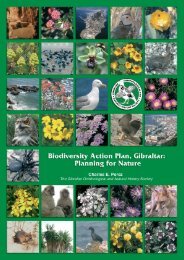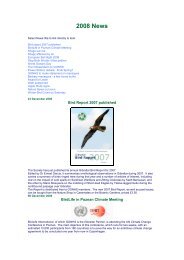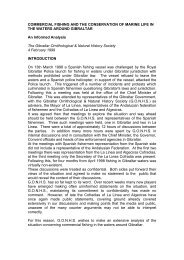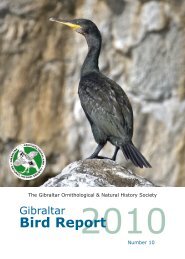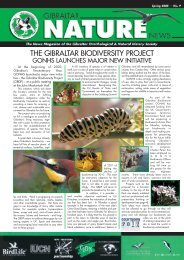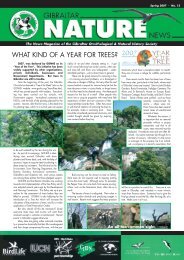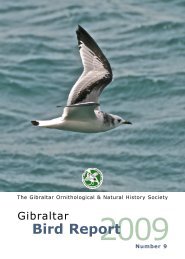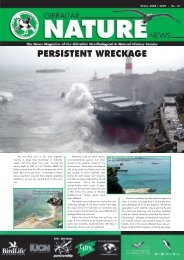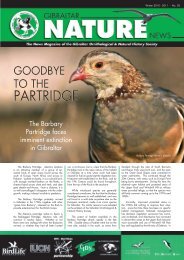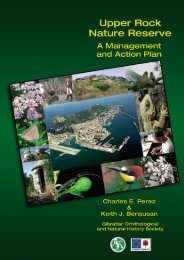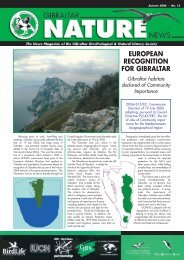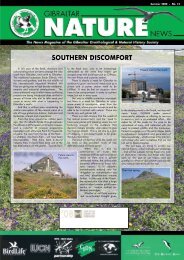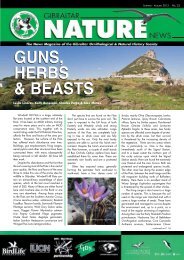ure News 11 - Gibraltar Ornithological & Natural History Society
ure News 11 - Gibraltar Ornithological & Natural History Society
ure News 11 - Gibraltar Ornithological & Natural History Society
You also want an ePaper? Increase the reach of your titles
YUMPU automatically turns print PDFs into web optimized ePapers that Google loves.
sun and thus a higher rate of evaporation, will contain<br />
many fewer stomata than the lower surface. In an<br />
attempt to further reduce water loss, the stomata may<br />
lie inside grooves formed on the leaf-surfaces, and in<br />
some species the leaves actually curl inwards, reducing<br />
water loss by evaporation even further. This is the<br />
case of the sea knotgrass Polygonum maritimum and<br />
several of the grasses found in the habitat. Others,<br />
such as the sea spurge Euphorbia paralias, have<br />
closely overlapping leaves towards the same aim.<br />
The mobility of the dunes is also a problem, as<br />
plants will have difficulty in rooting, and if they manage<br />
to do so they may get smothered by sand. But<br />
here the presence of marram grass Ammophila arenaria<br />
is important. This grass forms dense clumps<br />
which provide obstacles to the movement of the sand,<br />
and is thus an essential component in stabilising and<br />
consolidating the dune system.<br />
Many other attractive species are found on this<br />
habitat, and also further inland, including the middle<br />
slopes of the Faro promontory and even the Cape<br />
headland. Among these are: the shrubby pimpernel<br />
Anagallis monelli with its striking violet-blue flowers;<br />
the large-flowered knapweed Centa<strong>ure</strong>a sphaerocephala;<br />
the aromatic sea chamomile Anthemis maritima;<br />
the beautiful prickly thrift Armeria pungens and<br />
the parasitic dense-flowered broomrape Orobanche<br />
densiflora. From the carrot family, there are the tall<br />
Thapsia villosa subsp. maxima and the tiny<br />
Pseudorlaya pumila, which usually lies half-buried in<br />
the sand. In the more marshy areas among the<br />
dunes, there are small stands of sharp rush Juncus<br />
acutus and sea rush Juncus maritimus.<br />
The surface of the sand dunes is often crisscrossed<br />
by the tracks left behind by numerous beetles<br />
and also by the Spiny-footed Lizard Acanthodactylus<br />
erythrurus. This is more evident in the morning when<br />
the sand has been dampened by the night dew and<br />
is undisturbed. The Spiny-footed Lizard is so-called<br />
Rock platform along shoreline<br />
Centa<strong>ure</strong>a sphaerocephala<br />
because of the spines on its digits, which help it to<br />
walk across the sand. Acanthodactylus lizards are<br />
most diverse in desert regions and some species have<br />
highly developed spines to cope with the problem of<br />
running along sand dunes. Beetles walking along<br />
sand dunes are most often darkling beetles (family<br />
Tenebrionidae). Most residents of <strong>Gibraltar</strong> will be<br />
familiar with tenebrionid beetles. These are mainly<br />
large, black species with hard exoskeletons that prevent<br />
the loss of moist<strong>ure</strong>. Thus, they do extremely well<br />
Juniperus oxycedrus subsp. macrocarpa<br />
in arid habitats such as dunes and deserts.<br />
Particularly common species in dune habitats include<br />
Pimelia fornicata, Pachychila germari and a range of<br />
Tentyria species.<br />
The vegetation of the upper parts of the Faro<br />
promontory is quite different to that on the dunes<br />
nearer the shoreline. Here it forms a fairly dense<br />
scrub of low shrubs growing on the sand, the roots of<br />
which often lie exposed on the surface, criss-crossing<br />
the more open areas and footpaths. There are several<br />
species of shrubs, including olive Olea europea;<br />
narrow-leaved phillyrea Phillyrea angustifolia; lentisc<br />
Pistacia lentiscus; prickly buckthorn Rhamnus<br />
lycioides subsp. oleoides; rosemary Rosmarinus officinalis;<br />
shrubby scorpion vetch Coronilla valentina<br />
subsp. glauca; and two species of juniper: prickly<br />
juniper Juniperus oxycedrus subsp. macrocarpa, and<br />
Phoenician juniper Juniperus phoenicea. Of the<br />
species of rockrose present, the most abundant are<br />
Halimium commutatum, which has rosemary-like<br />
leaves and Halimium halimifolium, which has broader,<br />
grey leaves. As can be expected, the exotic and<br />
invasive Hottentot fig Carpobrotus edulis is present in<br />
many places.<br />
The Faro comprises a good promontory from<br />
which to watch seabirds, particularly when onshore<br />
(westerly) winds blow during the spring and autumn<br />
migration periods. Morning watches are easiest during<br />
sunny days since the sun is in your eyes in the<br />
afternoons. As elsewhere along this coast, passage<br />
of Gannets Morus bassanus, Cory’s Shearwaters<br />
Calonectris diomedea, gulls and terns can be impressive.<br />
Its location on the Atlantic coast makes it a likely<br />
site at which rarer species may turn up. The Great<br />
Shearwater Puffinus gravis has been seen here in<br />
autumn for example. Off the town of Barbate itself,<br />
whale-watching tours take place as there is a resident<br />
population of Killer Whales Orca orca offshore.<br />
To the south of the Faro lie the impressive sea<br />
cliffs of the ‘Tajo de Barbate’. These hold a colony of<br />
Yellow-legged Gulls Larus michahellis, as well as<br />
Jackdaws Corvus monedula and a pair of Peregrines<br />
Falco peregrinus. Until recently, these cliffs also supported<br />
a large colony of Cattle Egrets Bubulcus ibis<br />
and a few pairs of Little Egrets Egretta garzetta.<br />
These have moved away to nest in nearby La Janda,<br />
however.<br />
For the present, this coastline is in pristine condition,<br />
and free from the type of intensive touristic<br />
developments that afflict other coastlines in the area,<br />
especially along the Costa del Sol. But for how long,<br />
one can only speculate. It doesn’t take much to imagine<br />
some developer eyeing the large expanse of<br />
clean, sandy beaches and making plans to “improve”<br />
the area with new roads, hotels, etc. The recently<br />
designated ‘Parque <strong>Natural</strong> del Estrecho’ does not<br />
stretch this far north. Every effort should be made to<br />
conserve all of what is still a coastline of exceptional<br />
importance to wildlife of all forms.<br />
Silene littorea<br />
Halimium halimifolium<br />
GIBRALTAR NATURE NEWS<br />
13



